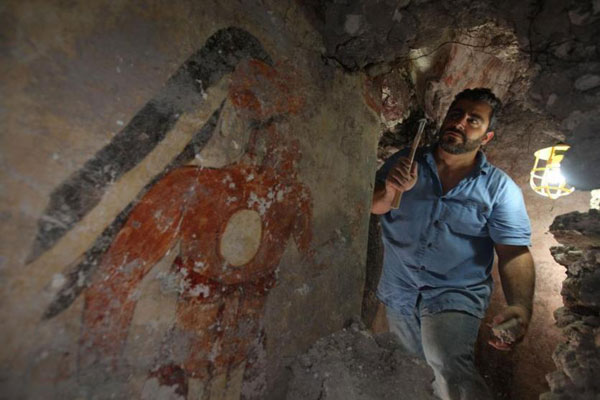
Xeni Jardin at 3:16 pm Friday, May 11
An archaeological expedition in the northeastern lowlands of Guatemala yields an amazing discovery: the "9th-century workplace of a city scribe, an unusual dwelling adorned with magnificent pictures of the king and other royals and the oldest known Maya calendar."
From Thomas Maugh's report in the Los Angeles Times, on the dig in the ruins of Xultun led by William Saturno of Boston University:
This year has been particularly controversial among some cultists because of the belief that the Maya calendar predicts a major cataclysm — perhaps the end of the world — on Dec. 21, 2012. Archaeologists know that is not true coach outlet, but the new find, written on the plaster equivalent of a modern scientist's whiteboard coach factory outlet, strongly reinforces the idea that the Maya calendar projects thousands of years into the future.
To paraphrase modern-day Maya priests I've spoken with on past travels in rural Guatemala: "Well, duh."
The findings were first reported Thursday in the journal Science. The full text of the report requires paid subscription, but a recent Science podcast covers the news, and is available here (PDF transcript or MP3 for audio).
A related story at USA Today by Dan Vergano.
The astronomical calendar was unearthed from a filled-in scribe's room. While about 7 million Maya people still live in Central America today, the "Classic" Maya civilization of pyramid temples had collapsed there by about 900 A.D., leaving only a few birch-bark books dating to perhaps the 14th century as records of their astronomy, until now.
"The numbers we found indicate an obsession with time and cycles of time, some of them very large," Saturno says. "Maya scribes most likely transcribed the numbers on the wall in this room into (books) just like the ones later seen by conquistadors."
Explorers first reported the site of Xultun, once a large Maya center, in 1915. But it was only two years ago that National Geographic Society-funded archaeologists noted a small residential room partly exposed by looters. The room's walls proved to hold murals and small, delicate hieroglyphs inscribed in rows between paintings of scribes and rulers that not only corresponded to a 260 day ceremonial calendar and 365-day year, but the 584-day sky track of Venus and 780-day one of Mars.
And at the Boston Globe, Carolyn Johnson has a report here:
Scholars who study the Maya said the well-preserved room provides insights into the people’s lives beyond those drawn from the more lasting stone monuments and artifacts that archeologists often depend on to reconstruct ancient civilizations. It’s almost as if the researchers can peer over the shoulders of the scribes who were writing and thinking there. The BU-led team reported sections of the wall had been plastered over to make space for new text.
“For me what’s really amazing is people are erasing and changing it and adapting it,” said Charles Golden, associate professor of anthroplogy at Brandeis University, who was not involved in the research. “You get these works in progress that really humanizes this, it kind of demystifies it.”

William Saturno, a Boston University archeologist, excavates a mural in a house in Xultun. Photo: Tyrone Turner © 2012 National Geographic
Photo: Tyrone Turner © 2012 National Geographic. Zoomable "Gigapan" here.
没有评论:
发表评论